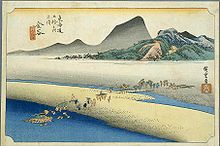- Kanaya-juku
-
Kanaya-juku (金谷宿, Kanaya-juku?) était la vingt-quatrième des cinquante-trois stations du Tōkaidō. Elle est située dans ce qui est à présent une partie de la ville de Shimada, préfecture de Shizuoka au Japon. Durant la période Edo, c'était la station la plus à l'est de la Province de Totomi.
Sommaire
Histoire
Kanaya-juku fut construite sur la rive droite du fleuve Ōi-gawa en face de Shimada-juku. Il y avait plus de 1 000 bâtiments dans la station, dont trois honjin, un honjin secondaire et 51 hatago[1]. Les vyageurs avaient un accès facile à Nissaka-shuku, qui était éloigné d'environ 6.5 km[1]. Cependant, quand les rives du fleuve étaient inondées, les voyageurs ne pouvaient traverser Kanaya et se rendre à Shimada-juku car le Shogunat Tokugawa avait expressément interdit la construction de ponts sur le fleuve Ōi .
La classique estampe ukiyoe d'Ando Hiroshige (édition Hoeido) datant de 1831–1834 dépeint une procession de daimyo de sankin kotai traversant le fleuve. Le daimyo est dans un kago, tenu à flot par une plateforme improvisée portées par de nombreux serviteurs qui pataugent dans l'eau du fleuve. A l'arrière-plan, un petit village se tient au pied de la colline.
Stations voisines
- Tōkaidō
- Shimada-juku - Kanaya-juku - Nissaka-shuku
Sources
- Carey, Patrick. Rediscovering the Old Tokaido:In the Footsteps of Hiroshige. Global Books UK (2000). ISBN 1901903109
- Chiba, Reiko. Hiroshige's Tokaido in Prints and Poetry. Tuttle. (1982) ISBN 0804802467
- Taganau, Jilly. The Tokaido Road: Travelling and Representation in Edo and Meiji Japan. RoutledgeCurzon (2004). ISBN 0415310911
Notes et références
- (ja)Ochakaidō: History of Kanaya-juku. Ochakaidō Cultural Association.
- (en) Cet article est partiellement ou en totalité issu de l’article de Wikipédia en anglais intitulé « Kanaya-juku » (voir la liste des auteurs).
Wikimedia Foundation. 2010.

